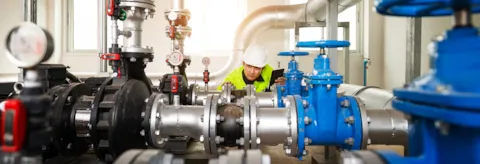Hydrogen, ammonia and other new energy commodities to deliver over a quarter of emissions reductions in Asia Pacific, says DNV
Green fuels and feedstocks, including hydrogen, ammonia, sustainable fuels and carbon sequestration, will be responsible for over 25% of emissions reductions in Asia Pacific by 2050, according to a new report from DNV.
- While electrification and renewables will drive most of the energy transition in APAC, new energy commodities (NECs) remain essential, in particular for hard-to-abate sectors.
- International trade is pivotal to deliver deep decarbonization, with 81% of NECs expected to be cross-border.
- The total NEC market in APAC is estimated to be around USD 1.1 trillion per year - or around 3% of the estimated regional GDP for 2050.
While most of the region’s net zero transition will be achieved through electrification and the expansion of renewable energy, the latest research from the independent energy expert and assurance provider finds new energy commodities (NECs) will be vital for decarbonizing six sectors: aviation, maritime, steel, power, industrial chemicals and cement.
Together, these clean fuels will significantly enhance sustainability in the region, accelerating economic development and supporting growing populations, while the increased selection of energy sources will also increase resilience to global price shocks and supply shortages.
Building on DNV’s Energy Transition Outlook, The role of new energy commodities in decarbonizing Asia Pacific assesses the role of NECs in achieving net zero in APAC and has been launched during the Asia Clean Energy Summit (ACES), held in conjunction with Singapore International Energy Week (SIEW) 2025.
Amid recent uncertainty surrounding market stimulus for hydrogen and its derivatives - resulting in project delays and slowed investment - DNV’s report aims to spotlight the scale of opportunity by offering practical guidance to unlock potential, such as the industry-led harmonization of standards and certification frameworks, enabling technical interoperability and market access..

Brice Le Gallo, Vice-President and Regional Director, Asia Pacific, Energy Systems at DNV said: “Reaching net zero won’t be possible without NECs, especially in Asia-Pacific where diverse solutions are needed due to the region’s geography. Hydrogen, ammonia, sustainable fuels, and carbon capture are essential for industries that are hard to decarbonize. Without expanding NECs, these sectors risk falling behind.
“Our study shows that scaling up these technologies will change how energy is traded across the region and will need major investment, strong partnerships and bold innovation. The transformation ahead is huge and both governments and businesses must rise to the challenge."
Geographical imbalances between countries with cost-efficient supply and those with concentrated industrial demand mean that international trade will play a pivotal role in future APAC energy markets.
DNV expects 81% of NECs to be traded and, as a result, scaling these fuels will require pragmatic mechanisms for cross-border interoperability across the region.
By 2050, Japan, South Korea and Singapore are expected to be among the largest NEC consumers in APAC, but limited domestic supply will make them heavily reliant on imports.
Australia, meanwhile, is well-positioned to lead in meeting regional demand, though emerging regional and international producers are rapidly scaling up and could become strong competitors in the future.

“Within the region’s diverse range of countries, six key industries (aviation, maritime, steel, power, industrial chemicals and cement) will depend heavily on NECs to achieve deep decarbonization,” said Thomas Koller, Regional Hydrogen, Ammonia and Sustainable Fuels Lead, Asia Pacific, Energy Systems at DNV.
“From sustainable aviation fuel in the skies to ammonia and methanol powering ships in Singapore, and hydrogen driving green steel, each sector has a clear pathway. Carbon capture and storage (CCS) will also play a critical role, particularly for steel and cement, where direct electrification is not yet feasible.”
Meeting demand from these sectors will require extensive new infrastructure across APAC, including some 12 billion solar panels and 2.7 million wind turbines by 2050 – equivalent, for example, to nearly 240 times the current combined solar and wind capacity of Australia.
In addition, 189 new ports and 1,221 carriers need to be built to support new energy commodity production and trade in the region.
DNV’s research pinpoints three strategic priorities to accelerate adoption of new energy commodities across APAC, including building resilient regional supply chains through infrastructure investment and aligned standards. Focus must also be given to managing biomass resources in aviation and maritime through balanced, flexible strategies, as well as enabling carbon capture and storage for hard-to-abate industries by strengthening market signals with carbon pricing, mandates and certification frameworks.
Le Gallo added: “The energy transition is already happening, with emissions expected to peak this year. To meet APAC’s climate goals, we need to completely rethink how energy is made, moved and used.
“Strong policies across all countries are crucial to speed up the use of new energy sources and tackle challenges like high costs, lack of infrastructure and inconsistent standards. Full regional alignment is tough, but practical cooperation between countries can help scale up industrial decarbonization.”
